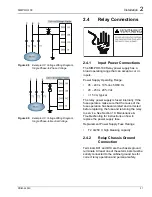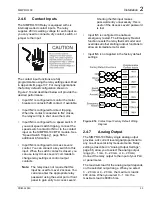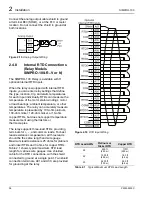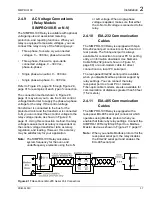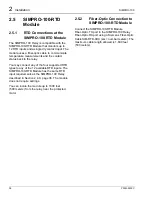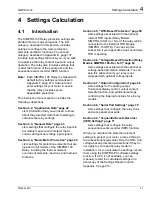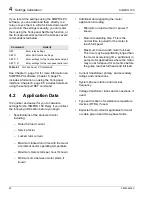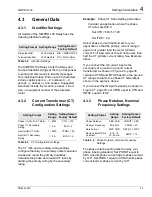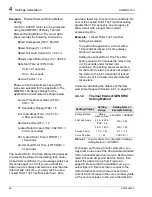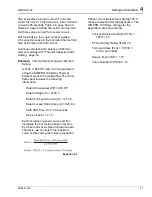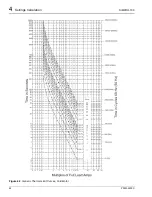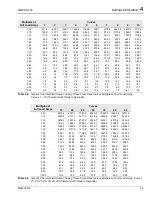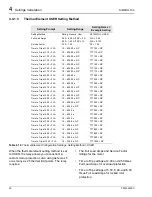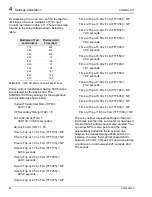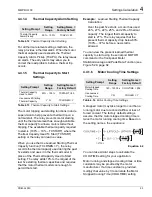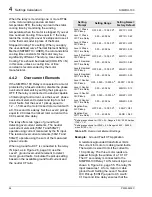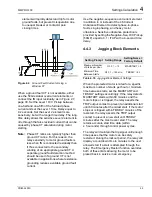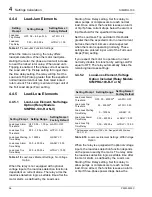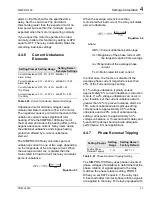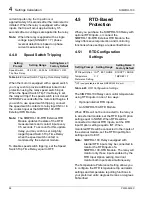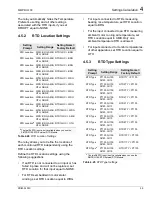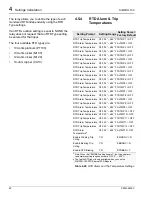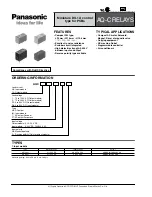
SIMPRO-100
Settings Calculation
4
PRIM-2400C
45
4.4
Basic Motor
Protection
4.4.1
Thermal Model Element
The SIMPRO-100 Relay motor thermal element
provides integrated protection for all of the
following motor operating conditions:
•
Locked Rotor Starts
•
Running Overload
•
Unbalance Current/Negative-Sequence
Current Heating
•
Repeated or Frequent Starting
This protection is provided using any of the three
available relay setting methods. The Setting
Method setting offers three options: Rating,
Generic, and User.
Rating Setting Method
When selected, the relay configures a thermal
curve based on the motor Full Load Amps,
Service Factor, Locked Rotor Amps, Hot and
Cold Locked Rotor Time, and Locked Rotor
Trip Time Dial settings.
Generic Setting Method
When selected, the relay offers 45 standard
motor thermal limit curves which you can
select by curve number.
User Setting Method
When selected, the relay allows you to build a
customized thermal limit curve by directly
entering from 5 to 25 time-current points
based on your motor’s published thermal limit
curve.
All three thermal element setting methods can
provide outstanding motor protection. In each
case the relay operates a thermal model with a
trip value defined by the relay settings and a
present heat estimate that varies with time and
changing motor current. The relay expresses the
present motor thermal estimate as a % Thermal
Capacity. When the % Thermal Capacity reaches
100%, the relay trips. You can see the present %
Thermal Capacity value using the relay front
panel Meter Values\Thermal & RTD Data function
or the serial port METER T command.
4.4.1.1
Thermal Element RATING
Setting Method
Table 4.6
Thermal Element Configuration Settings,
Setting Method = RATING
When you select the RATING thermal element
setting method, the relay requests information on
the protected motor capabilities. Obtain all of the
requested information except the Locked Rotor
Trip Time Dial from the motor specifications.
Occasionally, only one locked rotor time will be
specified for a particular motor. Unless the
specification states otherwise, assume the time is
the cold locked rotor time. Multiply the cold locked
rotor time by 0.833 to determine a hot locked
rotor time that is acceptable for most motors. If
only the hot locked rotor time is specified, multiply
that value by 1.2 to determine a cold locked rotor
time that is acceptable for most motors.
Setting
Prompt
Setting
Range
Setting Name =
Factory Default
Setting Method
Rating, Generic,
User
SETMETH = RATING
Full Load Amps 2.50 – 8.00 A ITAP
= 5 A
FLA = 5.00
0.50 – 1.60 A
a
ITAP = 1 A
FLA = 1.00
Service Factor
1.00 – 1.50
SF = 1.15
Locked Rotor
Amps
7.50 – 80.00 A
ITAP = 5 A
LRA = 30.00
1.50 – 16.00 A
a
ITAP = 1 A
LRA = 6.00
Hot Locked
Rotor Time
1.0 – 200.0 s
LRTHOT = 2.1
Cold Locked
Rotor Time
1.0 – 240.0 s
LRTCOLD = 2.5
Locked Rotor
Trip Time Dial
0.10 – 1.50
TD = 1.00
a
The range of the Full Load Amps and Locked Rotor Amps
settings depends on the ITAP setting as shown.
Summary of Contents for SIMPRO-100
Page 1: ...SIMPRO 100 Motor Protection Relay Instruction Manual Document No PRIM 2400C ...
Page 12: ...Contents SIMPRO 100 x PRIM 2400C ...
Page 16: ...Contents SIMPRO 100 xiv PRIM 2400C ...
Page 42: ...3 SIMPRO PC Software SIMPRO 100 40 PRIM 2400C ...
Page 100: ...6 ASCII Serial Port Operation SIMPRO 100 98 PRIM 2400C ...
Page 127: ...SIMPRO 100 Event Analysis 9 PRIM 2400C 125 Figure 9 2 Example SER Report ...
Page 136: ...10 Maintenance Troubleshooting SIMPRO 100 134 PRIM 2400C ...
Page 138: ...A Firmware Versions SIMPRO 100 136 PRIM 2400C ...
Page 206: ...D SIMPRO PC Compatibility Features SIMPRO 100 204 PRIM 2400C ...
Page 214: ...E Motor Thermal Element SIMPRO 100 212 PRIM 2400C ...
Page 230: ...F SIMPRO 100 Relay Settings Sheets SIMPRO 100 228 PRIM 2400C ...
Page 239: ......

